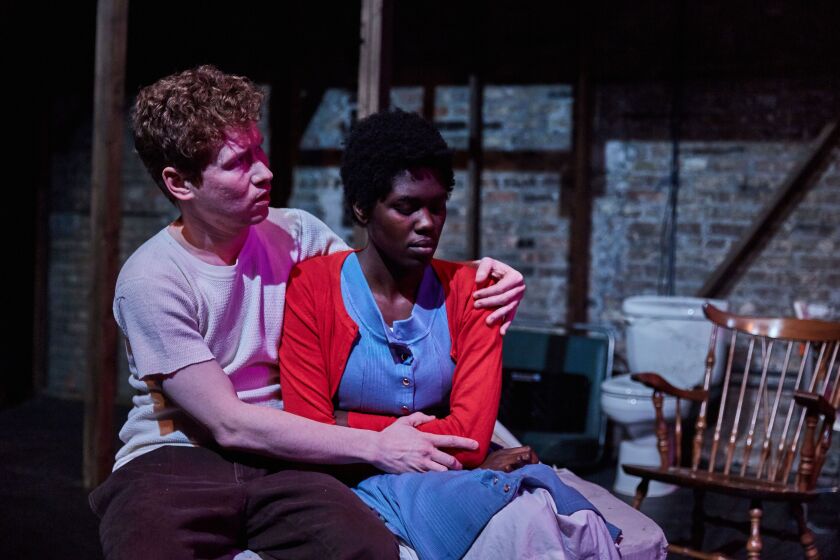At first glance, a co-producing partnership between Cor Theatre and Stage Left Theatre doesn’t look like an easy fit. Cor looks for edgy, experimental plays that defy conventions; Stage Left takes a more traditional path with works that challenge and inspire debate on the political and social landscape. So finding a play that fit both missions proved to be a daunting task.
Stage Left embarks on one co-production each season, but in 2015 after four months of passing plays back and forth with Cor and not finding a winner, both companies took a breather promising to revisit another project down the road.
It was a bit of serendipity that eventually led to a renewal of the partnership last year and the current staging of Maria Irene Fornes’ “What of the Night?,” a collection of four related plays (“Nadine,” “Springtime,” “Lust” and “Hunger”) that together become a sweeping epic that follows the members of an extended family as they attempt to figure out how to survive in a compassionless world.
It all began when Cor artistic director Tosha Fowler brought one of the plays, (“Springtime”) to a DePaul University theater class she was co-teaching with playwright/director Carlos Murillo. Unaware that the play was part of a bigger story, she was surprised when Murillo “got really excited” and started telling the class about the play and Fornes, who was his mentor when he was first starting out.
Murillo told Fowler he had long wanted to direct “What of the Night?” and offered to do so at Cor if Fowler also loved it. She read the play and instantly took him up on the offer.
“It’s a crazy play but it’s also beautiful,” says Fowler of the play, one of Fornes’ works that is rarely staged. “It met Stage Left’s mission as its very politically charged and about power and greed and sex and violence and how it all intertwines. It is a jump aesthetically for them but they are excited to bring something new and wild to their audience.”
Fornes (“Fefu and Her Friends,” “Mud”) was a leading fixture on the Off-Off- Broadway scene of the ‘60s. “What of the Night?” was first performed as a whole in 1989 and was a Pulitzer Prize finalist that year. Murillo, who heads the playwriting program at The Theatre School at DePaul, was in his early twenties when he first met the Cuban-born Fornes at a retreat at the Hotchkiss School.
“I was a young writer and she was there as a master writer,” Murillo recalls. “She was vibrant, irreverent and a natural storyteller. She’s been a huge influence on me.“
Fowler says Fornes “is a poet with an interesting perspective that is very specific about dialogue and character.” Each play in the quartet presents a very different style.
Fowler explains: “’Nadine,’ set during The Depression, is very Steinbeck. ‘Springtime’ reminds me of a foreign film because it is so detailed and small. Big crazy ‘Lust’ is like a wackier, gruesome version of [the movie] ‘Wall Street.’ And ‘Hunger’ is set in a future post-apocalyptic world frequented by the haves and the have-nots.”
Murillo admits putting all these pieces together has been a challenge: “It’s definitely not your traditional play. It’s sort of like a series of separate tapestry panels that are made up of all these memories. When you put them together, it becomes this huge all-encompassing event.”
Fornes, now 86, has suffered with Alzheimer’s for nearly two decades. Murillo bemoans the fact that her plays are not better-known. While her work isn’t easy to pigeonhole, those who know it feel she was a game changer.
“I think it’s one of the tragedies of our theater that she is not a national treasure,” Murillo says, adding, “She has a singular voice and vision. What she made possible on stage is a collision of a hyperrealism with a magical theatricality. Her writing is vivid and fearless and filled with moments of aching humanity juxtaposed with grotesque brutality. The language, the imagery, it’s all just so fascinating.”
Mary Houlihan is a local freelance writer.

Casey Morris plays Charlie and Dionne Addai is Birdie in Cuban-American writer María Irene Fornés’s Pulitzer-Prize nominated play “What of the Night?” Chicago’s Cor Theater and Stage Left Theatre co-present, and Carlos Murillo directs, Fornés’s epic, deeply intimate and never-more-timely mediation about poverty in America. | Ian McLaren







